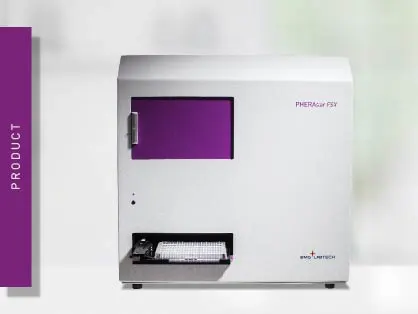
PHERAstar FSX
Powerful and most sensitive HTS plate reader
Multi-mode microplate readers typically employ a broadband light as an excitation source to cover as many assays and applications as possible. This is commonly either a tungsten halogen or a xenon lamp. Read about how the settings of your excitation light source affect measurement results in the HowTo Note: How does the number of flashes influence measurement results?
Halogen lamps
Halogen lamps cover the wavelength range from 360 nm to more than 1000 nm and are hence unsuited for absorbance-based DNA/RNA (260 nm) and protein (280 nm) quantification, as well as for UV fluorescence intensity measurements. Halogen lamps are continuous light sources. They have a shorter lifetime, a lower output intensity, and result in lower sensitivity when compared to xenon lamps in microplate reader-based detection. Because of their cost-effectiveness, they are typically used on low-cost instruments.
Xenon flash lamps
Xenon flash lamps cover the spectral region from 220 nm to 1000 nm (fig. 1). They are suited to excite any molecule that absorbs light from the UV- to the infrared range. In addition, since they are flash lamps, they combine a long lifetime with a high signal output when compared to continuous wave lamps such as halogen ones.
BMG LABTECH equips all its microplate readers only with high-performance xenon flash lamps, providing more excitation energy over a broader spectral range and a larger range of assays at lower concentrations. This allows all types of biological, light-based assays to be efficiently measured on a BMG LABTECH microplate reader.
Because of their flashing nature, xenon lamps have a much longer lifetime when compared to continuous halogen ones. Xenon flash lamps have a lifetime of hundreds of thousands of flashes Typically, the emission intensity is decreased by 50% after around 100,000,000 flashes. For standard life science applications, this translates into years of use, before any decline in functionality is noticed.
An easy way to determine if your xenon flash lamp is declining in intensity is to look at an experiment that has been repeated over several years in your laboratory. If you notice that the gain setting (under the protocol information tab in a MARS test run) has increased with time although using the same sample concentration, then the intensity of the lamp could be decreasing.
Alternatively, if you have preventative maintenance visits scheduled, your local BMG LABTECH service team will regularly test its performance.
Powerful and most sensitive HTS plate reader
Most flexible Plate Reader for Assay Development
Flexible microplate reader with simplified workflows
Upgradeable single and multi-mode microplate reader series